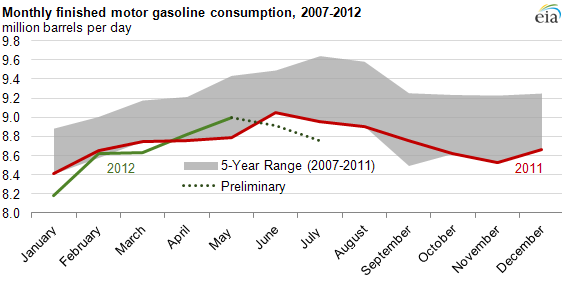
Estimated U.S. gasoline consumption low compared to five-year average

Note: Product supplied measures the amount of gasoline that went into the supply chain and is used as a proxy for gasoline consumption. Data for 2011 come from the Petroleum Supply Monthly. Data for 2012 reflect a mix of available monthly data and weekly data from the Weekly Petroleum Status Report
U.S. gasoline consumption in the first quarter of 2012, which averaged about 8.5 million barrels per day (bbl/d), was down 124 thousand bbl/d compared with the same time last year, continuing the trend of lower consumption and higher prices. However, the second quarter of 2012 shows some signs of higher consumption. Gasoline prices since the beginning of May 2012 were lower than the same time last year, and gasoline consumption showed some very modest gains in April and May.
U.S. gasoline consumption peaked in 2007 at 9.3 million bbl/d and fell by an average of 3.2% (300 thousand bbl/d) in 2008 due to the recession and high gasoline prices, which topped $4 per gallon in June and July 2008. Gasoline prices fell in late 2008 and remained below $3 per gallon through 2009 and 2010, but gasoline consumption remained flat, increasing by just 0.1% in 2009 and falling slightly in 2010. Regular-grade gasoline prices rose in early 2011, peaking at an average of $3.91 per gallon in May 2011, and for the year averaged $0.74 per gallon higher than the year before. In response to higher prices, households again cut back on highway travel, and gasoline consumption fell by 2.9% (260 thousand bbl/d) in 2011 from the year before.
This year, weekly gasoline prices, which generally peak in early summer, peaked at the beginning of April. During the first three months of 2012, regular-grade gasoline prices averaged $0.31 per gallon higher compared to the same period for 2011, and gasoline consumption in that period averaged 124 thousand bbl/d lower. Since April 2, 2012, gasoline prices fell for 13 consecutive weeks, primarily due to falling crude oil prices. While gasoline prices during the first four months of 2012 were higher than the year before, gasoline prices showed year-over-year declines in May and June.
Along with prices, current economic conditions and vehicle fleet efficiency have also affected gasoline consumption. The amount of highway travel, and thus motor gasoline consumption, is generally linked to economic conditions. Real Gross Domestic Product for the first quarter of 2012 was 2.4% higher than it was in the same period a year earlier, and preliminary data indicate that the growth rate was slightly lower during the second quarter, at 2.2%. However, Real Personal Disposable Income, which also affects gasoline consumption, has been growing at a much lower rate in 2012, namely 0.1% during the first quarter, with preliminary data for the second quarter indicating a growth rate of 1.3%. This helps explain why gasoline consumption was relatively low during the first three months of 2012, but may be showing some slight growth in the second quarter compared to data from a year earlier. Another factor affecting gasoline consumption is increases in vehicle fleet fuel efficiency that help reduce gasoline consumption, as more efficient vehicles use less fuel for each mile driven.
Gasoline consumption trended lower during the first three months of 2012 compared to the same months in 2011. April 2012 was the first month this year to show some growth (55 thousand bbl/d) compared to data a year ago, with consumption in May 2012 more than 200 thousand bbl/d higher than in May 2011. So far this year the monthly consumption level has been greater than the sum of the weekly consumption estimates by an average of about 159 thousand bbl/d. An increase of that magnitude from the weekly data for June would make June gasoline consumption about flat compared with last year. As this article was being published, gasoline prices were trending upward, but it is too soon to see the effect on consumption.